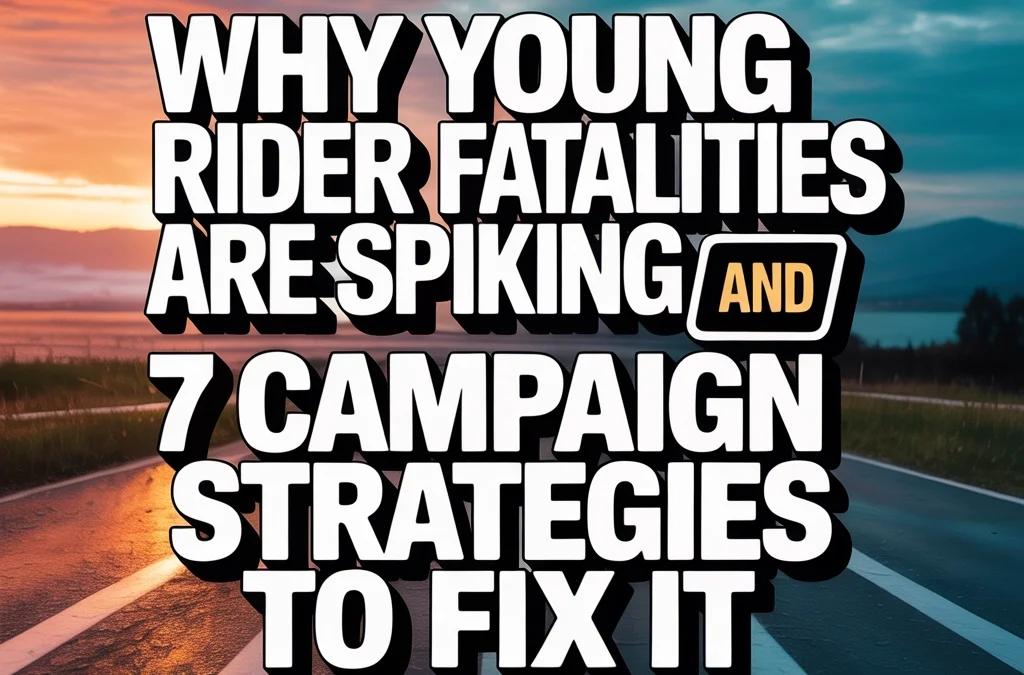Quick Answer: Young motorcycle rider fatalities are increasing due to inexperience, risk-taking behaviors, and insufficient safety training. Effective campaign strategies include peer mentorship programs, enhanced rider education, technology integration, community partnerships, graduated licensing improvements, targeted summer interventions, and parent engagement initiatives that address the root causes of dangerous riding behaviors.
The statistics tell a troubling story. Young motorcycle riders, particularly those between 16-25 years old, are experiencing fatality rates that climb each year despite advances in motorcycle technology and safety gear. This isn't just numbers on a spreadsheet – these are real lives cut short, families devastated, and communities grappling with preventable tragedies.
Understanding the Spike in Young Rider Deaths
The Perfect Storm of Risk Factors
Young riders face a unique combination of challenges that older, more experienced motorcyclists have learned to navigate. Brain development research shows that the prefrontal cortex, responsible for risk assessment and impulse control, doesn't fully mature until the mid-twenties. This biological reality combines with the thrill-seeking nature of youth to create dangerous riding scenarios.
The summer months see particularly devastating increases in fatalities. Longer daylight hours, school breaks, and group riding activities create more exposure opportunities. When you add inexperience to increased riding time, the results become tragically predictable.
Technology Paradox
Ironically, modern motorcycles have become both safer and more dangerous for young riders. Advanced braking systems, traction control, and stability management help prevent crashes, but these same technologies can give inexperienced riders false confidence to push beyond their skill limits.

The Seven Campaign Strategies That Work
1. Peer Mentorship Networks
Nothing resonates with young riders like authentic stories from peers who've been through similar experiences. Successful peer mentorship programs pair experienced young riders with newcomers, creating authentic relationships that go beyond traditional safety lectures.
These programs work because they address the social dynamics that influence riding decisions. When a respected peer shares lessons learned from close calls or mistakes, the message carries weight that adult authorities simply cannot match.
2. Immersive Reality Training
Move beyond classroom instruction to create visceral learning experiences. Virtual reality crash simulations, controlled emergency braking exercises, and scenario-based training help young riders understand consequences without experiencing them firsthand.
The most effective programs combine high-tech simulation with real-world practice in controlled environments. This approach builds muscle memory and decision-making skills that kick in during actual emergencies.
3. Community Integration Initiatives

Partner with local motorcycle dealerships, riding clubs, and community organizations to create comprehensive support networks for young riders. When the entire motorcycling community takes responsibility for newcomer safety, individual riders feel accountable to higher standards.
Successful community programs often include mentorship matching, group rides with safety focus, and recognition systems that celebrate safe riding achievements rather than just speed or stunts.
4. Technology-Enhanced Monitoring
Smartphone apps and motorcycle-integrated systems can provide real-time feedback on riding behaviors. These tools work best when they gamify safety rather than simply monitoring violations.
Progressive programs reward safe riding with discounts on insurance, gear, or motorcycle services. The key is making safety feel rewarding rather than restrictive.
5. Parent and Family Engagement
Many motorcycle safety campaigns ignore parents entirely, assuming young adult riders make independent decisions. Research shows family influence remains significant, even for riders in their twenties.
Effective family engagement programs educate parents about motorcycle safety basics, help them ask the right questions, and provide frameworks for setting reasonable expectations around riding activities. You can learn more about comprehensive safety approaches at our main site.
6. Graduated Licensing Enhancement

Push for motorcycle licensing systems that gradually increase privileges based on demonstrated competence rather than just time served. Some states have implemented systems requiring additional training or testing before riders can operate high-performance motorcycles or ride with passengers.
These enhanced systems work when they focus on skill building rather than arbitrary restrictions. The goal should be developing competent riders, not creating bureaucratic obstacles.
7. Summer Surge Response Programs
Since fatalities spike during summer months, develop targeted interventions for peak riding season. These might include increased safety course availability, special events focused on group riding safety, and enhanced emergency response training for areas with high motorcycle traffic.
Summer programs work best when they feel like positive community events rather than safety crackdowns. Motorcycle rallies, skills competitions, and gear exchanges create positive associations with safety activities.
Implementation Reality Check
Start Small, Scale Smart
The most successful motorcycle safety campaigns begin with pilot programs in specific communities or demographics. Test approaches, measure results, and refine strategies before attempting large-scale implementation.
Focus on metrics that matter – not just awareness levels or course completion rates, but actual behavior changes and crash reduction in target populations. For inspiration on effective campaign strategies, check out our recent analysis of successful safety initiatives.
Coordination Challenges
Multiple stakeholders must work together for meaningful impact. Law enforcement, DMV agencies, riding instructors, motorcycle manufacturers, and rider advocacy groups often have different priorities and approaches.
Successful coordination requires identifying shared goals and creating structures for ongoing collaboration rather than one-time partnerships.
The Path Forward
Young rider fatalities represent a solvable problem, but solutions require sustained commitment beyond awareness campaigns. The most effective approaches address root causes – inexperience, peer pressure, and inadequate training systems – rather than just symptoms.
Measuring Success
Real progress means fewer families receiving devastating phone calls, fewer talented young people losing their lives to preventable crashes, and a motorcycling community that takes collective responsibility for nurturing safe, skilled riders.
The strategies outlined here have shown promise in pilot programs and international implementations. Success depends on local adaptation, sustained funding, and community buy-in from riders themselves.
Every young life lost to a motorcycle crash represents not just personal tragedy, but missed contributions to families, communities, and the riding culture itself. With focused effort and evidence-based approaches, we can reverse the trend of rising young rider fatalities.
Ready to make a difference in motorcycle safety? Connect with Dan Kost, CEO at Ride Fear Free, LLC to discuss implementing effective safety campaigns in your community. Visit www.RideFearFree.net or call our AI Receptionist at +1 (970) 693-4854. Connect with Dan on LinkedIn for ongoing safety insights and campaign updates.
Share this article: Help spread awareness about young rider safety initiatives.
Tags: #Motivation #Branding #Strategy #Marketing #AdvertisingAndMarketing #digitalmarketing #Innovation #Sports #MotorcycleSafety #RiderEducation #YouthSafety #CampaignStrategy #SafetyTraining #RiskReduction

